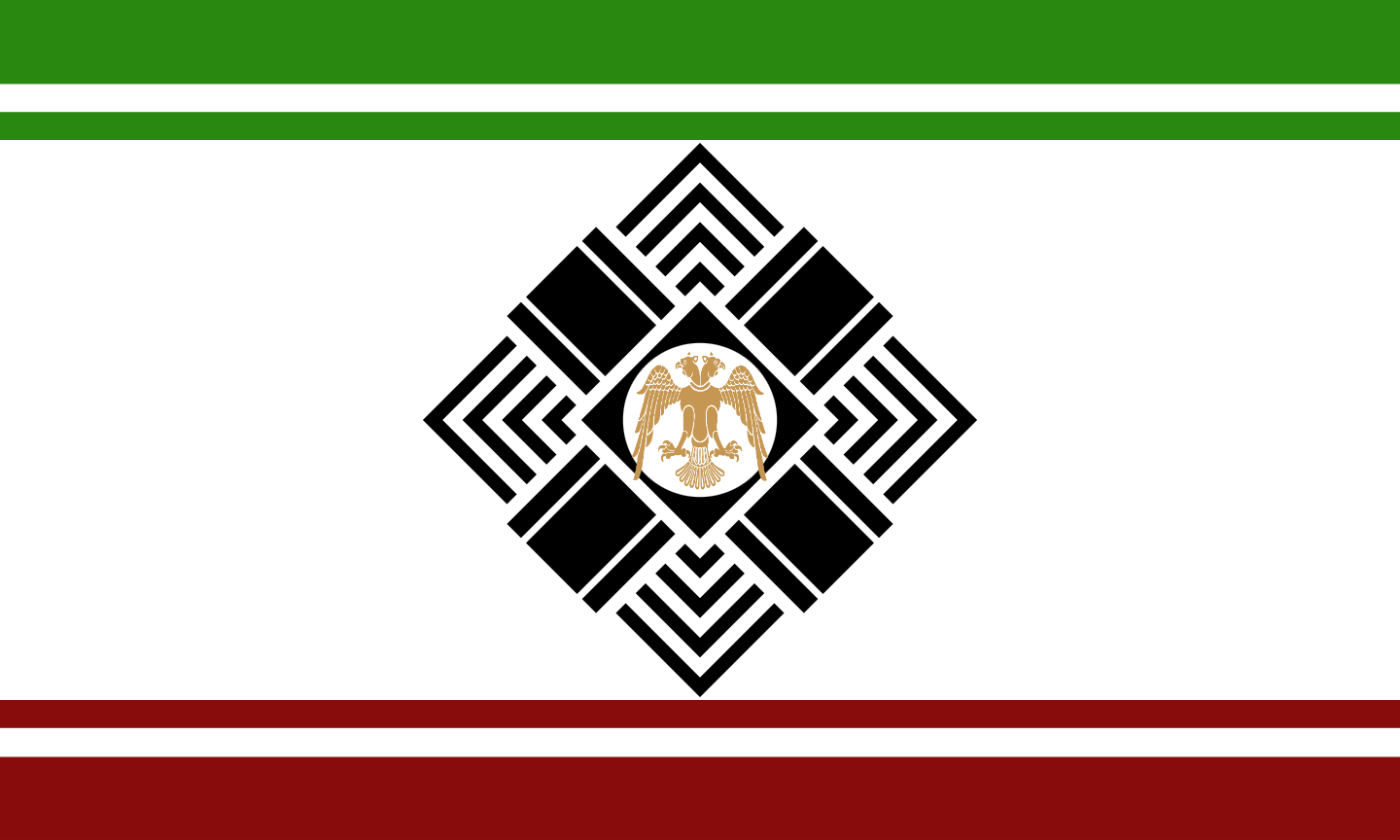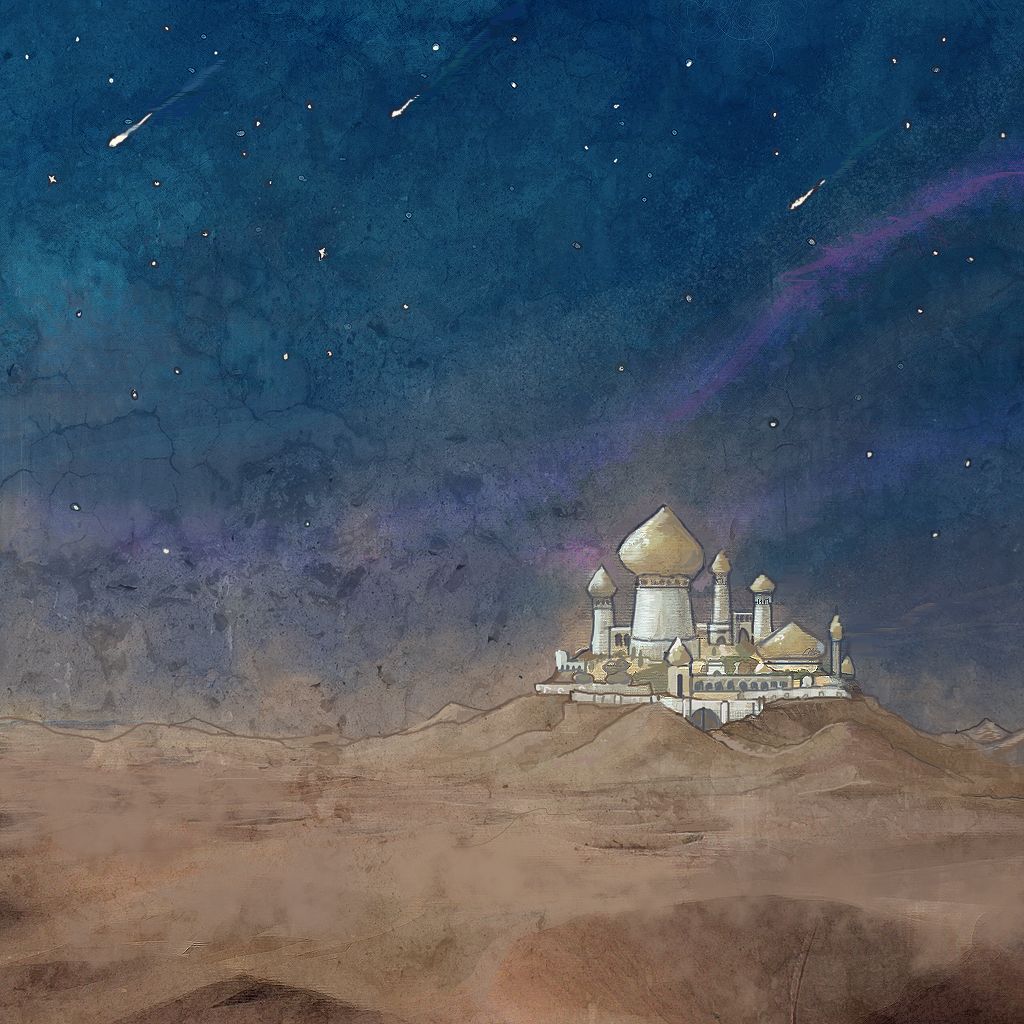The Grand Chaliphate of Ashad
The Grand Caliphate of Ashad is thousands of years old, but it has had many dynasties that have functioned in various ways, and its power has waxed and waned many times. It is the largest nation in the most southern part of the continent. It has alternated between a strong trade power with ambitions of grandeur, and being isolationist and cut off from the world. It is currently in a phase of the latter and quite suspicious of its neighbours.
Structure
Geographically, the empire was divided into several provinces, the borders of which changed numerous times during the Hadad reign. Each province had a governor appointed by the Grand Caliph. The governor was in charge of the religious officials, army leaders, police, and civil administrators in his province. Local expenses were paid for by taxes coming from that province, with the remainder each year being sent to the central government in Domilia. As the Hadad ruler Nasir al-Hadad is unpopular amongst the nobles, some governors neglected to send the extra tax revenue to Domilia and created great personal fortunes
Culture
Society in Ashad was divided between nomadic Shaa'douin, who roamed the wide harsh lands of the continent with their herds in close-knit tribal groups, and the settled Shaladar, who prided themselves on their cultural sophistication no matter if they lived in small villages or vast cities. Both groups were deeply skeptical of the other's lifestyle, but were united by common language, faith, and a shared distant past.
Note that there is no separation of the population on terms of race - an Elvish Shaa'douin will most often feel closer to a Human Shaa'douin than to an Elvish Shaladar. The society of Ashad has absolutely no native racial tendencies; ogres, orcs and half-orcs are as much a part of the established socity as elves, humans and dwarves. The person is judged on the basis of his actions, not of his race.
The Shaladar were above not very accurately described as city-dwellers. It would be more correct to describe them as the part of the population that lives a stationary life, be that in a city, a small village, or perhaps on an isolated farm-stead. The Shaa'douin on the other hand, are nomads. Their life is centered around the deserts of Ashad, where they live the often tough and difficult life of a wanderer. Both of the two groups are however very necessary to Ashad's society, each supplying to the whole what the other cannot. The Shaa'douin have their herds and their caravans, while the Shaladar have their merchants, their crafts-men and their farmers. This is a fact often overlooked by the people themselves, the two groups are in general sceptical towards the other. Even the lowliest of Shaladar consider themselves more cultured and civilized than any Shaa'douin. They usually have a home, enough to eat and drink, and an easier life. Also, they have ordered priest performing their religious seremonies in mosques, and therefore consider themselves more pious and in accordance with the gods. The Shaa'douin, on the other hand, consider it more pious to live under the open sky, daring the dangers of the deserts, where the whim of the gods is what in the end decides who lives and who does not. Also, the Shaa'douin see the Shaladar as soft, and pity what they see as lack of freedom.
There are several very important perspectives of life to the people of Ashad. In the end, the way you live the life you have been given is what decides how the people around you view you. Rules are what govern the Shaa'douin society, rules set down by tradition, and by the Lore-giver. To a Shaa'douin, honour is the essence of everything. If a man has no honour, he is not a man. Being honourable and being good are very much the same thing in Ashad. Everything you do or do not, in some way influences your honour. A deed will either give you more or less honour in the eyes of those around you. Crime is also an aspect of honour. To damage some other persons honour will by this other person and by most others be considered a crime for which restitution must be made. Sometimes an excuse is enough, sometimes it isn't. The result of no restitution would in most cases lead to a blood feud. Killing is not a crime if it is justified - though there are no clear rules as to what "justified" entails. Note, however, that only two crimes automatically leads to the death penalty; murder and improper love.
Another aspect of honour is family. The family is the most important thing in a Shaa'douin 's life. Any act of one member of the family not only influences the honour of that person, but the honour of the whole family. Divorce is legal, and marriage is the only family tie that can be broken. Relatives of the blood will continue to influence the honour of a family for all time. Therefore a family will often kill a member of the family who seriously damages the honour of the family. Usually this happens if some family member have commited rape, or in any other way have acted improper with relations to love or signs of affection. It is important to avoid any unnecessary physical contact with someone you are not married to, otherwise it might be considered such an improper action.
Hospitality is essential. Custom and honour demands that you offer food and drink to anyone who pays you a visit - whether the guest is invited or not. But a guest who overstays his welcome equally debases his own honour by taxing on other unnecessarily. The bond of salt is important here. Once a guest have eaten salt from the table of the host, they are formally bonded, where the two owe each other mutual protection and help. Salt is considered as remaining in the body for three days.
Honour and religion are very much the same thing. Being honourable is demanded by any god in the Land of Faith, and an unhorouble man is also an impious one. A man without honour cannot expect to be found worthy by any god to enter the paradisical afterlife. Any person not pract- icing a religion, will be looked upon with disdain and lack of trust by Shaa'douins.
History
Ashad was an ancient empire with a history that spanned more than nine millennia and was categorized by sages into 15 periods.
Ancient
During the oldest known history of the area, the forests of the south covered the entire land. Here, dragons and giant-kin battled amidst its deapts. Primitive humans migrated to different points around the area while ancient earth elementals founded the city of Jarus. In 7800 AC, the djinn arrived (along with their genasi slaves from the elemental planes) in the area around where Domilia would later stand and founded the Dhômm'ahssid Empire; clearing much of the forest that previously stood as well as driving out the dragons and giants that ruled the area. By 7690 AC, led by their djinn noble namesake, the Dhômm'ahssid Empire had expanded north to the Valley of Drakes.Hadad's Conquest
In 379 PC the ruler of Omrah, Nasir al-Hadad, was invited by the Grand Caliph Akbaru II Toma in Domilia to serve as the Grand Caliph's personal spymaster during the First Jarusi Revolt to gather information about the unruly Shaa'douin tribes in the Sea of Dust. In that year, Nasir crossed the Gulf of Gifts and inflicted a severe defeat on the Sand-Riders. By 395 PC, Nasir had removed all Pro-Toma governours in ashad, removed Grand Caliph Akbaru Toma and had annexed the capital and the southern holdings.Demography and Population
Individuals native to the continent of Ashad tended to have darker hair and skin.
Ashad is overwhelmingly human. This wasn't as pronounced before, but with the rise of the Hadad dynasty, the country became more isolationist after around 395 PC. Other races started to feel less welcome and many emigrated or had a hard time finding success.
Notable Organisations
Desert raiders
Dozens of nomadic raiding groups resided in the desert. One of these groups was attacked by the one who would later become the Grand Caliph Nasir al-Hadad, who sought to claim the throne of Ashad in 378 PC. In 388, the Grand Caliph gave orders to his military to seek out and annihilate these nomadic peoples.The Children of the Elder Elementals
This secret order of genasi had one of its keeps hidden in the capital ,waiting and working for the djinni's return.Territories
The Sand Sea
Ashad is famous for this desert which reflected a definitive Arabian ambiance. Also known as the the Sea of Screams, this rocky and sandy desert lies in the interior of continental Ashad. It was not formed by natural means, instead being the result of an epic magical war between three genies, the djinni Nuson, the dao Edra and the efreeti Jareq. The sands hid the ruins of ancient cities, which were said to hold many treasures. A single major highway ran through it from Domilia to Al-Shaladar where caravans dodged bandits from various raider factions. The most impressive and feared faction of the desert were the Dark Raiders who always leave one sole survivor.Foreign Relations
Education
There was a major school, called the Grand School, in the capital founded by the Toma dynasty as a gift to the people. In the beginning, only 50 students were allowed to study at the Grand School. In less than 100 years, enrollment at the Grand School was over 30,000 students

One From Many, By Force of Will, Forged by Might, Driven by Fire, Born by Death to Rise Eternal
Maps
-
Ashad map
A detailed map of the southern part of the continent of Khondwanaq, the Jewel of Civilization. The lands of Ashad are mostly desert but beneath the shifting sands and sunbaked rock this land holds great treasures, secrets of a forgotten age and ancient magic best kept hidden.
Founding Date
-2500
Type
Geopolitical, Theocracy
Capital
Alternative Names
Land of Faith,
Demonym
Shaa'douin
Leader
Leader Title
Head of State
Head of Government
Government System
Monarchy, Theocratic
Power Structure
Feudal state
Economic System
Market economy
Currency
1 gp = 1 gold "dinar"
= 10 silver "dirham"
= 100 copper "bits"
Location
Related Ranks & Titles
Controlled Territories
Notable Members
Related Ethnicities
Trade Dealings
Trade Dealings
Both nations have sent well-received delegations.




Comments